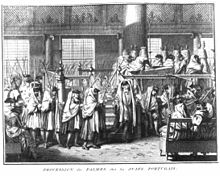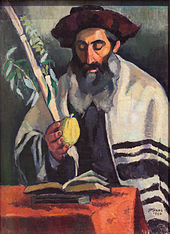Sukkot
![]()
This article is about the Jewish Feast of Tabernacles. For other meanings, see Sukkot (disambiguation).
Sukkot (Hebrew סֻכּוֹת, unpunctuated spelling סוכות, plural of סֻכָּה Sukka, German 'Laubhütte', Yiddish Sukkes or Sikkes) or Feast of Tabernacles is among the Jewish festivals. The festival is celebrated in the fall, five days after the Day of Atonement, in September or October, and lasts for seven days, from the 15th to the 21st of Tishri, the first month of the civil Jewish calendar. In Israel and Liberal Judaism, only the first day is a full holiday, but in Orthodox and Conservative communities in the Diaspora, the first two days are, while the following days are semi-holidays (חול המועד Chol HaMoed). The last day of Sukkot is called הושענא רבה Hoshanah Rabbah and is considered the last day until which Divine rulings for the year can still be changed. Immediately following the Feast of Tabernacles are שְּׁמִינִי עֲצֶרֶת Shmini Azeret, "the Eighth Day of Assembly," and שִׂמְחַת תּוֹרָה Simchat Torah, "the Feast of Torah Joy."

Leopold Pilichowski: Sukkot, 1894/95, Jewish Museum New York
History
The festival, which is mentioned several times in the Torah, is, like the two other Jewish pilgrimage festivals Passover and Shavuot, of peasant and probably Canaanite origin and has in common with them the historical-agricultural dual character. The feast has already changed in antiquity during centuries, which is reflected in the biblical and post-biblical texts. In the 2nd Book of Moses it is called the "Feast of Gathering" (Chag ha'Assif, Ex 23:16-19 GNB and Ex 34:22 GNB) and only in the 3rd Book of Moses it is called the "Feast of Tabernacles" (Chag ha'Sukkot, Lev 23:34 GNB) with a duration of seven days: "When not only the grain harvest but also the wine harvest is gathered, you shall celebrate the Feast of Tabernacles for seven days. Observe it as a festival of joy with your sons and daughters, your male and female slaves, and with the Levites in your city, the strangers who live with you, the orphans and widows." (Dt 16:13-17 GNB) The tabernacles here probably mean the shade-giving shelters in the fields (Jonah 4:5 GNB), such as are still in use today in the Near East at harvest time. It was not until after the Babylonian exile that the date was set for the 15th of the seventh month and Sukkot became a historical festival, justified by the desert migration after the Exodus from Egypt and prescribing the dwelling in tabernacles during the festival period (Lev 23:33-43 GNB). According to tradition, King Solomon dedicated the Temple in Jerusalem at Sukkot (1 Kings 8:2 GNB), and in the Messianic age, according to the prophet Zechariah (Zech 14:16-19 GNB), Sukkot will be a universal festival associated with rain, for which all neighboring nations will make a pilgrimage to Jerusalem.
At the time of the Herodian Temple
In the Mishnatraktat Sukka the ceremonies at the time of the Second Temple are listed, especially the water scooping ceremony, which as well as the processions with fruits and tree and palm branches, the "Four Species" of plants (Hebrew אַרְבָּעָה מִינִים Arba'a minim), during which psalms were sung, are associated with rain.
In John's Gospel, on the last day of the Feast of Tabernacles (Jn 7:2 GNB), Jesus calls to those who are thirsty (Jn 7:37 GNB), which is interpreted in the context of a water-scooping ceremony common at that time from the first to the last day of the feast.
The historian Flavius Josephus describes the festival as an eight-day celebration, during which people lived in huts and sacrificed in the temple; Philo of Alexandria describes it as a seven-day harvest festival, to which an eighth day is added as a culmination, under the sign of equality and justice.
What remained after the destruction of the Temple were: the seven-day festival of Sukkot, the Azeret on the eighth day, the Sukkah, the Arba'a minim and the Hallel prayer, and the request for rain on the eighth day.

Hakkafot of the Sephardic Jews in the Portuguese Synagogue in Amsterdam, 18th c.
Sukkot today
The seven-day festival of Sukkot is today, especially outside Israel, of importance mainly for observant Jews. In contrast, the Feast of Torah, which follows the Feast of Tabernacles, enjoys great popularity, especially among families with children. Chol HaMoed (Hebrew חול המועד) refers to the "in-between" holidays of Sukkot (and Passover). These days blend the characteristics of a חול "chol" (weekday) and a מועד "moed" (festival day). On Sukkot, Chol HaMoed consists of the second through seventh days (third through seventh in the Diaspora). Although Hoschana Rabba, the seventh day of Sukkot, has its own name, it is also a part of Chol HaMoed.
Sukka
→ Main article: Tabernacle
In memory of the Exodus from Egypt, when the Israelites lived in temporary dwellings, every year on Sukkot, wherever there is space - in the garden, courtyard, parking lot, balcony or roof - the sukkah is built, a hut covered with branches, straw or leaves, which must stand in the open air. In it, weather permitting, meals are eaten during the seven-day duration of the festival; particularly law-abiding Jews even spend the night in the tabernacle. Jewish communities usually create a congregational sukkah where the Kiddush after services and other receptions during Sukkot take place.
Worship
It begins with the blessing Shehecheyanu. In reference to the ancient harvest festival and the ceremonies associated with rain and fertility, the arba'a minim are worn during Sukkot services in the synagogue. The Hebrew term arba'a minim "four species" refers to the four types of plants in the festive bouquet. Thus, in the festive bouquet are found:
- a bound palm branch (lulav), which gives the name to the ostrich,
- three branches of myrtle (hadassim)
- and two brook willow branches (arawot) carried in the right hand,
- and the etrog, a variety of citron, held in the left hand.
The Arba'a minim are turned in six directions during the Hallel prayer, first to the east, then to the south, to the west, to the north, to the top and finally to the bottom. Toward the end of the service, a procession (Hakkafot in Hebrew) takes place in which one or more Torah scrolls are carried around the reading desk and those present, in Orthodox congregations only the men, follow with the arba'a minim, in memory of the processions around the altar in the Temple at Jerusalem recorded in the Talmud. On the seventh, final day, Hoschana Rabba "the great Hoschana" (German Hosiana, hilf doch!), there is not just one procession, but seven, while praying for a good harvest. Afterwards, five brook willow branches tied together are tapped five times, again in remembrance of the traditions of processions during the Second Temple period, according to which brook willow branches were carried around the altar in a procession seven times on this day. Only since post-Talmudic times has Hoshanah Rabbah been considered the day on which the annual judgments passed by God on the Day of Atonement become binding on the individual.

Paula Gans: In prayer at the Feast of Tabernacles, 1920Museum of Hamburg History
_in_Bnei_Brak.JPG)
Sukkah extensions on a residential house in Bnei Brak, Israel, 2012
Search within the encyclopedia